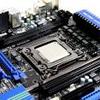Overclocking - the Core i7-3960X on MSI X79
Overclocking - the Core i7-3960X on MSI X79
Prior to the official benchmark session we want to show you some l33t / g33k stuff first. On this page we'll fire up two 3DMark benchmark sessions, first we take the reference / baseline results with 3DMark Vantage and 3DMark 11.
In several test runs, we'll see if we can overclock the processor a little while we have it at hand so we'll pop in an ASUS MARS II graphics cards (review here), and see if I can shatter my own dual-GPU record. For that to happen we'll need to lock in a high clock frequency though!
Anyway, here's the reference default performance. The card used is the ASUS MARS II graphics cards. This is the MSI X79 motherboard and the Core i7-3960X processor at default reference settings. Memory is set at 1333 MHz C9 (Quad-channel). The PSU used is the Enermax MaxRevo 1350W PSU (review here). OS is Windows 7 64-bit SP1 all patched and updated running with the latest NVIDIA WHQL drivers.
Reaching new heights - Overclocking
With so much ridiculous horsepower in the system, (engineering samples we must add) we could not resist trying out overclocking. We're keeping it simple, but anything over Gulftown on LCS (roughly 4.2 GHz) would be a win in my book for this six-headed beast.
Pretty much we need to take a couple of steps if we want to overclock. Invest in good hardware by the way, the cheaper motherboards often are not well tuned for enthusiast overclocking.
Manual overclocking
The true guru3d audience overclocks from the BIOS and try to find the maximum stable limit. The generic overclock procedure for multiplier based overclocking is as follows:
- Leave baseclock for what it is right now
- If optional in the BIOS, increase your TDP limits of the processor to 250 Watts (by that you are allowing a higher power draw)
- Leave your base multiplier at default e.g. 34
- Set the per core Turbo multiplier at a maximum of your liking, we applied an MP of 50 on all six cores
- Increase CPU voltage, though setting AUTO might work fine, we applied 1.5V on the processor cores
- Make sure your processor is properly cooled (we used the Corsair H100 LCS cooler at performance settings)
- Save and Exit BIOS / EFI
So these settings allow us to work at a baseline clock of roughly 3400 MHZ that can actually still throttle down to 1200MHz in idle, which helps us in power consumption. However, once the processor gets a kick in the proverbial nuts, it can turbo any or all cores towards that multiplier of 50 times that 100 MHz baseclock frequency, that's a 5000 MHz configuration.

Let's have a quick look at a Prime95 stress test with all four cores active and stressed at ~5000 MHz. As you can see, you'll need a rather reasonable cooler as temperatures are on the borderline of acceptable. Then again, six-cores all at 5 GHz with a high-voltage, we didn't expect any less.
At a later stage (not included in this article) we got the CPU steady at 5.2 GHz as well on all six cores. So the OC potential is enormous, especially combined with 6 active CPU cores.

